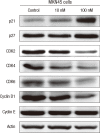Suppressive effect of 19-nor-1α-25-dihydroxyvitamin D2 on gastric cancer cells and peritoneal metastasis model
- PMID: 22969249
- PMCID: PMC3429820
- DOI: 10.3346/jkms.2012.27.9.1037
Suppressive effect of 19-nor-1α-25-dihydroxyvitamin D2 on gastric cancer cells and peritoneal metastasis model
Abstract
The active metabolite of vitamin D, 1,25-dihydroxyvitamin D(3) (calcitriol), inhibits the growth of several types of human cancer cells in vitro, but its therapeutic use is limited because it causes hypercalcemia. Among its analogs, 19-nor-1,25-dihydroxyvitamin D(2) (paricalcitol), has fewer calcemic effects and exhibits an activity equipotent to that of calcitriol. We assessed the antitumor and anti-inflammatory effects of paricalcitol in gastric cancer cells, and evaluated the potential role of vitamin D in the treatment of peritoneal metastatic gastric cancer. In this study, treatment with paricalcitol inhibited gastric cancer cell growth and induced cell cycle arrest. Paricalcitol also induced apoptosis and showed anti-inflammatory activity. Moreover, the growth of intraperitoneal metastases in vivo was reduced in mice treated with paricalcitol. (18)F-FDG uptake was significantly lower in the paricalcitol group compared to control group (SUV; control group 13.2 ± 5.3 vs paricalcitol group 4.5 ± 3.0). Intraperitoneal tumor volume was significantly lower in paricalcitol treated mice (control group 353.2 ± 22.9 mm(3) vs paricalcitol group 252.0 ± 8.4 mm(3)). These results suggest that the vitamin D analog, paricalcitol, has anticancer activity on gastric cancer cells by regulation of the cell cycle, apoptosis, and inflammation.
Keywords: Apoptosis; Neoplasms; Paricalcitol (19-nor-1α-25-dihydroxyvitamin D2); Stomach.
Figures







Similar articles
-
Antitumor effects of two less-calcemic vitamin D analogs (Paricalcitol and QW-1624F2-2) in squamous cell carcinoma cells.Oncology. 2006;70(6):483-92. doi: 10.1159/000098813. Epub 2007 Jan 18. Oncology. 2006. PMID: 17237623
-
Vitamin D2 analog 19-nor-1,25-dihydroxyvitamin D2: antitumor activity against leukemia, myeloma, and colon cancer cells.J Natl Cancer Inst. 2003 Jun 18;95(12):896-905. doi: 10.1093/jnci/95.12.896. J Natl Cancer Inst. 2003. PMID: 12813173
-
Paricalcitol, a vitamin d receptor activator, inhibits tumor formation in a murine model of uterine fibroids.Reprod Sci. 2014 Sep;21(9):1108-19. doi: 10.1177/1933719114537721. Epub 2014 Jun 12. Reprod Sci. 2014. PMID: 24925855 Free PMC article.
-
19-nor-1 alpha,25-dihydroxyvitamin D2 (paricalcitol) inhibits the proliferation of human pancreatic cancer cells in vitro and in vivo.Cancer Biol Ther. 2008 Mar;7(3):430-6. doi: 10.4161/cbt.7.3.5418. Epub 2007 Dec 13. Cancer Biol Ther. 2008. PMID: 18094617
-
1,25-Dihydroxyvitamin D3 suppresses gastric cancer cell growth through VDR- and mutant p53-mediated induction of p21.Life Sci. 2017 Jun 15;179:88-97. doi: 10.1016/j.lfs.2017.04.021. Epub 2017 Apr 29. Life Sci. 2017. PMID: 28465245
Cited by
-
A Case-Control Study of the Association between Vitamin D Levels and Gastric Incomplete Intestinal Metaplasia.Nutrients. 2018 May 16;10(5):629. doi: 10.3390/nu10050629. Nutrients. 2018. PMID: 29772698 Free PMC article.
-
Micronutrient Food Supplements in Patients with Gastro-Intestinal and Hepatic Cancers.Int J Mol Sci. 2021 Jul 27;22(15):8014. doi: 10.3390/ijms22158014. Int J Mol Sci. 2021. PMID: 34360782 Free PMC article. Review.
-
Vitamin D and Hypoxia: Points of Interplay in Cancer.Cancers (Basel). 2022 Mar 31;14(7):1791. doi: 10.3390/cancers14071791. Cancers (Basel). 2022. PMID: 35406562 Free PMC article. Review.
-
Role of Vitamin D in Head and Neck Cancer-Immune Function, Anti-Tumour Effect, and Its Impact on Patient Prognosis.Nutrients. 2023 May 31;15(11):2592. doi: 10.3390/nu15112592. Nutrients. 2023. PMID: 37299554 Free PMC article. Review.
-
Vitamin D: Metabolism, Molecular Mechanism of Action, and Pleiotropic Effects.Physiol Rev. 2016 Jan;96(1):365-408. doi: 10.1152/physrev.00014.2015. Physiol Rev. 2016. PMID: 26681795 Free PMC article. Review.
References
-
- Reichel H, Koeffler HP, Norman AW. The role of the vitamin D endocrine system in health and disease. N Engl J Med. 1989;320:980–991. - PubMed
-
- Holick MF. Vitamin D: a millenium perspective. J Cell Biochem. 2003;88:296–307. - PubMed
-
- Carlberg C. Current understanding of the function of the nuclear vitamin D receptor in response to its natural and synthetic ligands. Recent Results Cancer Res. 2003;164:29–42. - PubMed
-
- Issa LL, Leong GM, Eisman JA. Molecular mechanism of vitamin D receptor action. Inflamm Res. 1998;47:451–475. - PubMed
Publication types
MeSH terms
Substances
LinkOut - more resources
Full Text Sources
Medical

